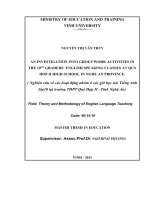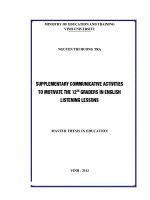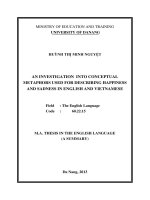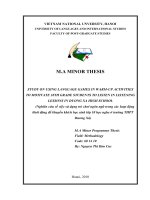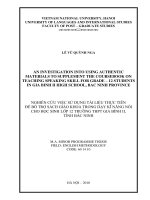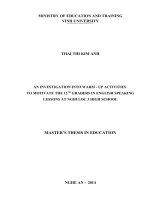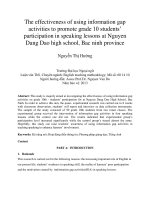An investigation into warm - up activities to motivate the 12th graders in English speaking lessons at Nghi Loc 3 high school
Bạn đang xem bản rút gọn của tài liệu. Xem và tải ngay bản đầy đủ của tài liệu tại đây (399.61 KB, 89 trang )
MINISTRY OF EDUCATION AND TRAINING
VINH UNIVERSITY
THAI THI KIM ANH
AN INVESTIGATION INTO WARM - UP ACTIVITIES
TO MOTIVATE THE 12TH GRADERS IN ENGLISH SPEAKING
LESSONS AT NGHI LOC 3 HIGH SCHOOL
MASTER’S THESIS IN EDUCATION
NGHE AN - 2014
2
MINISTRY OF EDUCATION AND TRAINING
VINH UNIVERSITY
THAI THI KIM ANH
AN INVESTIGATION INTO WARM - UP ACTIVITIES
TO MOTIVATE THE 12TH GRADERS IN ENGLISH SPEAKING
LESSONS AT NGHI LOC 3 HIGH SCHOOL
Major: Teaching English to Speakers of Other Languages (TESOL)
Code: 60140111
MASTER’S THESIS IN EDUCATION
Supervisor: NGƠ ĐÌNH PHƯƠNG, Assoc. Prof., Ph.D
Nghe An, 2014
4
STATEMENT OF AUTHORSHIP
I hereby declare that this thesis is my own work and effort and that has not
been submitted anywhere for any award. I certify that the thesis “An investigation
into warm - up activities to motivate the 12th graders in English speaking lessons
at Nghi Loc 3 high school” is the result of my own study and that it has not been
submitted to any other university or institution wholly or partially.
i
ACKNOWLEDGEMENTS
I am grateful to many people for their thoughtful help given to me in doing
this study.
Firstly, I would like to express my deepest gratitude to my supervisor - Mr.
Ngo Dinh Phuong for his insightful comments and suggestions on various parts of
this thesis.
My thanks also go to all my lecturers from the Post Graduate Studies
Department, Foreign Languages Department - Vinh University for their useful and
interesting lectures to finish the study.
I am most thankful to all my teachers of English and students in Nghi Loc 3
high school for their support in data collection.
Finally my special thanks go to my family, for their love and support throughout
this project. Without their encouragement I could not have completed this thesis.
ii
ABSTRACT
For some recent years, English has played more and more important part in
Vietnam, therefore, it has been taught in Vietnamese high schools as a compulsory
subject. So far, there have been remarkable changes in the way of teaching and
learning English. However, English teaching in general and teaching speaking in
particular still is far from satisfactory. How to motivate students to speak is really
necessary, and is a big question to almost teachers in Vietnam now. It is also the
question that has inspired me to investigate the use of language games in warm-up
activities to motivate 12th grade students to speak in speaking lessons. In attempt to
fulfill my thesis, the following process is made: Firstly, the theoretical background
of language games speaking skill and motivation is presented. Then, the survey
questionnaire for students was delivered to study the need of playing games in
English speaking lessons. Besides, the interview teachers has been carried out to
collect the information about the using language games in warm-up activities. In
addition, the researcher has observed some speaking lessons to find out the fact of
using language games in warm-up activities. From these methods, some suggestions
have been drawn out to help use language games more effectively. It is hoped that
this thesis will be found of value to those who have great interest in using language
games in warm-up activities in speaking lessons.
iii
TABLE OF CONTENTS
Page
STATEMENT OF AUTHORSHIP.....................................................................i
ACKNOWLEDGEMENTS..............................................................................ii
ABSTRACT.....................................................................................................iii
TABLE OF CONTENTS.................................................................................iv
LIST OF TABLES...........................................................................................vii
Chapter 1
INTRODUCTION.............................................................................................1
1. Rationale of the study................................................................................1
2. The aims of the study................................................................................1
3. Research questions....................................................................................2
4. Scope of the study.....................................................................................2
5. Methods of study.......................................................................................2
6. Organization of the study..........................................................................3
Chapter 2
THEORETICAL BACKGROUND..................................................................4
2.1. Speaking skill: ......................................................................................4
2.1.1. Definition of speaking........................................................................................4
2.1.2. The importance of speaking in language teaching programs............................6
2.1.3. Factors affecting English speaking abilities......................................................8
2.1.4. Problems with speaking activity........................................................................9
2.1.5. What Makes Speaking a foreign Language Difficult?.....................................10
2.2. Teaching English Speaking Communicatively.....................................14
2.2.1. An overview on Communicative Approach.....................................................14
2.2.2. Principles to teach speaking skill in C.A........................................................15
2.2.3. Principles for Teaching English Speaking in CLT..........................................16
2.2.4. Communicative Activities for Teaching Speaking .........................................17
2.3. Purpose of communicative activities....................................................23
2.3.1. Communicative activities improve motivation................................................23
2.3.2. Communicative activities allow natural learning............................................23
2.3.3. Communicative activities can creat a context which supports learning..........23
2.4. Speaking activities................................................................................23
2.4.1. A successful speaking activity..........................................................................23
2.4.2. Problems with speaking activities ..................................................................24
iv
2.5. Warm – up activities in speaking class.................................................25
2.5.1. Definition of warm – up activities...................................................................25
2.5.2. Teaching aims of using warm- up activities.....................................................26
2.5.3. Disadvantages of warm – up activities............................................................29
2.5.4. The role of the teacher in warm – up activities................................................31
2.5.5. How to organize warm – up activities:...........................................................31
2.6. General characteristics of the 12th graders.........................................33
2.6.1. The situation of using communicative activities in teaching speaking the 12th
graders in high schools...............................................................................................33
2.6.2. Principles of using warm up activities in speaking class in high school.........34
Chapter 3
METHODOLOGY..........................................................................................37
3.1. The Context of the Study......................................................................37
3.1.1. Description of the participants.........................................................................37
3.1.2. Desciption of the English 12 textbook.............................................................38
3.2. The Research Methodology..................................................................39
3.2.1. The Participants................................................................................................39
3.2.2. The Instruments of the Study...........................................................................39
Chapter 4
DATA ANALYSIS AND DISCUSSION.........................................................42
4.1. Finding..................................................................................................42
4.1.1. Questionnaires and Interviews for students.....................................................42
4.1.2. Questionnaire and Interviews for teachers.......................................................51
4.2. The class observations..........................................................................55
4.3. Conclusion............................................................................................57
Chapter 5
CONCLUSION..............................................................................................59
5.1. Findings................................................................................................59
5.1.1. The benefits of using language games in warm-up activities in speaking
lessons.........................................................................................................................59
5.1.2. The frequency of using language games..........................................................60
5.1.3. Difficulties in organizing and playing language games...................................60
5.1.4. Suggestions on using language games in warm-up activities in speaking
v
lesson...........................................................................................................................61
5.2. Recommendations................................................................................61
5.2.1. Takings the students’ personal factors and proficiency into consideration.....61
5.2.2. Using language games in a flexible and appropriate way...............................62
5.2.3. Using variety of language games.....................................................................63
REFERENCES................................................................................................64
APPENDIXES...................................................................................................1
vi
LIST OF TABLES
Table 4.1: Students’ view on speaking skill....................................................42
Table 4.2: Students’ participation in speaking activities.................................43
Table 4.3: The frequency of using language games in warm-up activities.....45
Table 4.4a: The students’ attitude toward language games in warm-up
activities...........................................................................................................46
Table 4.4b: Students’attitude towards teachers’ teaching speaking activities. 47
Table 4.5: The effectiveness of language games in warm-up activities in
speaking lessons..............................................................................................47
Table 4.6: Students'difficulties in taking part in warm- up activities..............49
Table 4.7: Solutions given by students to develop successful warm-up
activities...........................................................................................................50
Table 4.8: Teachers’ attitude toward using warm – up in English speaking....51
Table 4.9: Teachers' frequent warm-up activities in speaking lessons...........52
Table 4.10: Teachers' solutions to develop sucessful warm – up activities....54
vii
Chapter
1
INTRODUCTION
1. Rationale of the study
Nowadays, English is becoming more and more popular all over the world. It
is not only considered as the mother tongue in many countries but also used widely
in the world as an international language. It is the language of politics, science,
technology, commerce, tourism, sports, ect. In Vietnam, English has become a
compulsory subject in the curriculum at many secondary schools. In text-book,
students have to learn four skills (listening, speaking, reading, and writing) among
these skills speaking is a very important one for the purpose of communication.
Nevertheless, speaking does not receive adequate attention from both teachers and
students. In English classroom, teachers are mainly concerned with teaching what
students are tested in the exams, which is known as teaching to the test
phenomenon. As a result, after graduating from school, students are good at using
grammar structures and vocabulary, but find difficulties to speak English naturally.
In speaking lessons, students usually feel bored and frightened. To motivate and
encourage students to learn speaking is not an easy task for teachers. At the
beginning, to stimulate students to learn, warm-up activities should be stressed.
Using language games in warm-up activities becomes a good choice.
The main reasons above lead me to my choice of the subject: “An investigation
into warm - up activities to motivate the 12TH graders in English speaking lessons at
Nghi Loc 3 high school”.
2. The aims of the study
The study will emphasize the main following purposes:
1. Providing the basic literature review in terms of speaking, motivation and
language game.
2. Investigating the effectiveness of
using language games in warm-up
activities in speaking lessons of grade 12 in Nghi Loc high school.
1
3. Providing some suggestions and implications for the improvement of
speaking teaching in Nghi Loc High School in terms of using language games in
warm-up activities.
3. Research questions
The research plans to address the following questions:
Question 1: Are the students interested in taking part in warm – up activities
in English speaking class ?
Question 2: What are students’ attitudes towards their involvement in warm –
up activities?
Question 3: How do the teachers use language games in warm-up activities
in speaking teaching?
Question 4: What techniques should be used to improve speaking teaching in
terms of using language games in warm-up activities?
4. Scope of the study
Warm- up activities are varied, so for different skills at different levels we
have different choices. That is why it is impossible for the author to cover all things
related to the topic of the study. Only the most necessary knowledge about speaking
skills and warm- up activities are mentioned in the thesis.
With the above aims, this study is limited to the exploration of opportunities
and constraints as perceived by the teachers and students of Nghi Loc 3 high school
in Nghi Loc district in Nghe An with regard to the teaching and learning of English
speaking skills and some recommendations. The study only focuses on 2 of 7
classes, where there are teachers and students who are implementing the two new
English syllabuses for grades 12.
What is more, special attention is paid to warm- up activities which are
basically oral because they are the best to get students start talking –get ready for
speaking class time.
5. Methods of study
Due to the aims and scope of the study, the combination of quantitative and
2
qualitative methods is intended for the study:
•
The quantitative method has been obtained by survey questionnaires that
were given to both teachers and students at the high school mentioned in the study.
Those questionnaires are designed with variety of response options and thus are
easy to answer.
•
In order to gain the most successful result, data will be collected through
questionnaire . Collected data will be processed and analyzed.
•
The study employed qualitative approach. Data were collected via
interviews and classroom observations:
- Having classroom observations to get information about both teachers’ ways
of teaching and students’ ways of learning in class as well as to ascertain the
prevalent problems forwarded by the teachers during the interviews.
6. Organization of the study
This study consists of five chapters:
Chapter 1. Introduction - presents the rationale, the aims, the significance,
the scope, the methodology, and the organization of the study.
Chapter 2. Literature Review - provides a theoretical basis for the study.
Chapter 3. Theoretical background - includes the methods and procedures
used in the study, which consist of survey questionnaires, follow- up interview and
classroom observation.
Chapter 4. Data analysis and Discussion- deal with the findings drawn out
from the analysis of data. The findings and discussion are based on describing
English speaking classes in using warm – up activities among students and teachers
in Nghi Loc 3 high school
Chapter 5. Conclusion- draws some the conclusions of major findings,
recommendations, limitations for the study, and suggestions for further studies.
3
Chapter 2
THEORETICAL BACKGROUND
As a way of start, I will first provide the notions of speaking, teaching
speaking, factors affecting English speaking abilities and what a good speaking
learner should do. Then I will reexamine different types of stimulating activities the
foreign teacher often uses to teach a speaking class. Detailed of these contents are
presented in the sections that follow:
2.1. Speaking skill:
2.1.1. Definition of speaking
There are many definitions of speaking. According to Brown (1994), Burn and
Joyce (1997), speaking is “an interactive process of constructing meaning that
involves producing and receiving and processing information”. In a related study,
Bygate (1997) had a detailed definition which states that “speaking is the skill by
which learners are most frequently judged and through which they make and lose
friends. It is the vehicle par excellence of social solidarity, social ranking, of
professional advancement and of business. It is also the medium through which
much language is learnt”.
According to Florez (1999) demonstated speaking was “ an interactive process
of constructing meaning that involves producing and receiving and processing
information.” (cited in Bailey, 2005, p. 2). It is “often spontaneous, open-ended and
evolving”, but it is not completely unpredictable. In other words, “speaking consists
of producing systematic verbal utterances to convey meaning.” (Balley, 2005, p 2)
Bygate (1997) stated that speaking was a skill which deserved attention every
bit as much as literacy skill. It is often thought of as a “popular” form of expression
that uses the unprestigious “colloquial” register. Speaking is in many ways an
undervalued skill. Perhaps this is because we can almost speak, and so take the skill
to much for granted. In his own view, Mackey (1965) defines “Oral expressions
involves not only the use of the right sounds in the patterns of rhythm and
4
intonation, but also the choice of words and inflections in the right order to convey
the right meaning.” (cited in Bygate, 1997, p. 5). According to him, for the students
who want to be good at speaking, he/ she has to choose the right forms, put them in
correct order, sound it like native speaker and even produce the right meanings.
Therefore, speaking skills generally have to be learnt and practiced carefully before
giving a presentation.
Brown (1994 ) and Burns & Joyce (1997) define that speaking is an interactive
process of constructing meaning that involves producing, receiving and processing
information. When participating in communicative activities, the speaker should
choose the correct vocabulary to describe the things they want to say about, to
rephrase or emphasize words to clarify the description to produce the expected
pattern of specific discourse situations.
Despite the definitional diversity, in the present study, speaking skill is defined
as “the range of exercise types and activities with a communication approach is
unlimited, provided that such exercises and activities enable learners to attain the
communicative objectives of the curriculum, engage learners in communication and
require the use of such communicative processes as information sharing,
negotiation of meaning, and interaction”. (Richard and Rodgers, 1986, p. 165)
Speaking is an interactive process of constructing meaning that involves
producing and receiving and processing information (Brown, 1994, Burn and Joyce,
1997). Its form and meaning are dependent on the context in which it occurs,
including the participants themselves, their collective experiences, the physical
environment and the purposes for speaking .
It is often spontaneous, open-ended and evolving. However, speech is not
always unpredictable. Language functions that tend to recur in certain discoures
situations, can be identified and charted (Burn and Joyce, 1997). Speaking requires
that learners not only know how to produce specific points of language such as
grammar, pronunciation, or vocabulary but also that they uderstand why, when, and
in what ways to produce language.
5
In conclusion, speech has its own skills, structures and conventions different
from written language. Speaking skill is one of the key modes of human
communication, and one of the macro skills that language students should be helped
to develop for their communicative purposes. For that reason, teachers should help
their students to improve their speaking and overall oral competence.
2.1.2. The importance of speaking in language teaching programs
In my opinion, those who think the major objective of the students is reading
not speaking have ignored some obvious pedagogical facts:
Firstly, people have the notion that learning English has something to do with
oral English. When one says some students are good at English, people will
naturally think he or she can speak English well.
Secondly, oral English can be very useful for the development of reading and
writing skills. Speaking plays an utmost important role among the four language
skills since it helps to identify who knows or does not know a language. Pattison
(1992) confirms that when people know or learn a language, they mean being able
to speak the language.
In language teaching and learning, speaking is a medium through which much
language is learnt, and which is particularly useful for learning. The ability to
communicate in a second language clearly and efficiently contributes to the success
of the learners in school and success later in every phase of life (Kayi, 2006).
More than this, speaking is regarded as the first step to confirm who knows or
does not know a language. Ur (1996) shows that people who knows a language are
referred to as “speaker” of that language as if speaking included all other kinds of
knowing.
To many language learners “ mastering the art of speaking is the single most
important aspect of learning a second language or foreign language, and success is
measured in terms of ability to carry out a conversation in the language”. (Nunan,
1991, p. 39). It can be inferred from Nunan’s view point that speaking is a very
important skill among the four basic ones. Therefore, having dealt with the
6
importance of oral skills in language teaching and learning is essential that language
teachers should pay more attention to teaching speaking skills. In order to carry out
many of the most basic transactions, it is necessary for learners to speak with
confidence.
It is known that language is an effective means of communication through
which we can convey our ideas, our thought, or our desires. Language helps us
clarify what we mean. Without language, human beings have never achieved such
developments as they have done these days. It is language that makes human beings
distinctive from animals.
Many language learners consider speaking ability the measurement of
knowing a language. In other words, speaking skill is very important in language
teaching and learning. If learners do not learn how to speak or not to get
opportunities to speak, as many think, they may soon lose their interest in learning,
and learning the language is the way how to speak the language.
Bygate (1997, p. 5) stresses that speaking “is also a medium through which
much language is learnt, and which for many is particularly conductive for
learning”.
Nunan (1991) states that success in an oral conversation is measured in terms
of the ability to carry out a conversation in the target language. If a student doesn’t
know how to speak and has no chance to speak in the language classroom, he will
lose interest in learning. In the speaking class, on the contrary, if the teacher doesn’t
organize right and positive activities, the speaking a language will become less and
less boring.
Sharing the same ideas, Richard (1991) cites that it is the speaking skill that
helps learners to have communication which is the proper aim of language teaching.
According to Byrne (1991), while listening and reading are regarded as
receptive skills, speaking and writing are productive skill. Speaking not only helps
students to communicate well and exchange information and culture with others but
also promote the integration of speaking, listening, reading and writing in the ways
7
that reflect natural language use.
Similarly, Brown, G and Yule, G (1992) point out that speaking plays an ever
important role in a very transactional intention, that is, to make clear what they want to say.
From those points, we can come to a conclusion that speaking skill is one of
the most necessary skills in language teaching program. It suits the development
rules of human beings as one can speak before he can read and write. That is the
reason why speaking skill should be taught in the language room.
2.1.3. Factors affecting English speaking abilities
There are many factors that influence the success or failure in learning English
speaking. However, the three most important factors are motivation, attitude and
learning strategies.
Motivation is the first important factor affecting a language learner. According
to Gardner (2001), motivation refers to the driving force in any situation. In the
socio-educational model, motivation to learn the second language is viewed as
requiring three elements. First, the motivated individual expends effort to learn the
language. That is, there is a persistent and consistent attempt to learn the material by
doing homework, by seeking out opportunities to learn more, by doing extra work
and so on. Second, the motivated individual wants to achieve the goal. Such an
individual will express the desire to succeed, and will strive to achieve success.
Third, the motivated individual will enjoy the task of learning the language. Such an
individual will say that it is fun, challenging, and enjoyable, even though at times
enthusiasm may be less than at other times.
Attitude is the second factor which has an influence on the language learning.
Gardner and Lambert (1972) defined attitude as the persistence that a learner has to
follow an object. Language learning attitude has a relationship to motivation.
Language learners who have extrinsic or intrinsic motivation will have the more
positive attitude than those without motivation or who consider language learning a
compulsory subject.
Within second or foreign language education, a number of definitions of
8
language learning strategies have been used by key figures in the field. Early on,
Tarone (1983, p. 67) defined a language learning strategy as “an attempt to develop
linguistic and sociolinguistic competence in the target language to incorporate these
into one’s interlanguage competence”. Rubin (1987, p. 22) later wrote that language
learning strategies “are strategies which contribute to the development of the
language system which the learner constructs and affect learning directly”. In their
seminal study, O’Malley and Chamot (1990, p. 1) defined language learning
strategies as “the special thoughts or behaviours that individuals use to help them
comprehend, learn, or retain new information”.
2.1.4. Problems with speaking activity
Ur (1996) claims that a successful speaking ability should achieve a maximal
student taking time, even participation among students, student strong motivation to
speak and comprehensibility of students’ language. She points out some common
problems existing in practicing speaking activities:
Inhibition: learners often have a shy a nervous feeling while speaking,
especially in front of class or other people; they worried about making mistake,
fearful of losing face, criticism. Unlike reading, writing and listening activities,
speaking requires some degree of real time exposure to an audience. Students are
often inhibited about trying to say things in a foreign language in the classroom:
worried about making mistakes, fearful of criticism or losing face, or simply shy of
the attention that their speech attracts.
Nothing-to-say situations: when learners do not have anything to say due to
the lack of knowledge and low language proficiency or no motive to express
themselves beyond the guilty feeling. Even if they are not inhibited, you often hear
learners complain that they cannot think of anything to say. They have no motive to
express themselves beyond the guilty feeling that they should be speaking.
Low or uneven participation: when only a few participants dominate
discussion at a time in a large group meanwhile others speak little or not at all. In
some cases, some students have not any chance, intentionally or unintentionally, to
9
speak for a long time. Only one participant can talk at a time if he or she is to be
heard. In a large group this means that each one will have only very little talking
time. This problem is compounded by the tendency of some learners to dominate
while others speak very little or not at all.
Mother-tongue use: learners often share the same mother tongue and abuse
it in second language learning class because they feel the native language is easier
to use and it is not natural to speak to other in a foreign language. In classes where
all, or a number of, the learners share the same mother tongue, they may tend to use
it because it is easier. In addition, they feel unnatural to speak to one another in a
foreign language and they feel less ‘exposed’ if they are speaking their mother
tongue. If they are talking in small groups it can be quite difficult to get some
classes, particularly the less disciplined or motivated ones, to keep to the target
language.
When preparing activities for a speaking class, teachers should pay much
attention to above problems, so that the speaking activities will be successful and
useful to students.
2.1.5. What Makes Speaking a foreign Language Difficult?
2.1.5.1. Characteristics of spoken language
Speaking in a second or foreign language has often been viewed as the most
demanding of the four skills. When attempting to speak, learners must concentrate
their thoughts and encode their ideas in vocabulary and syntactic structures of the
target language.
According to Kathleen M. Bailey and Lance Savage (1993), depending on the
formality and importance of the speech situations as well as their own personal
linguistic propensities, the learners may also attend to monitor their output
(speaking skill).
These two linguists also add that in conversations and other interactive speech
events, the speakers must attend to the feedback from their interlocutors and observe the
rules of discourse used in the target culture. Phonological considerations add to the
10
difficulties to the task, especially for adult learners, as speakers strive to achieve “good”
pronunciation. The speed of such interaction is also an issue because their may not
be adequate time for processing either outgoing speech or incoming messages at the
typical rate of native-speaker interactions.
All of these factors combine to make speaking in a second or foreign language
a formidable task for language learners.
2.1.5.2. Difficulties in learning to speak a foreign language
Burn and Joyce (1997, p. 134) identify three sets of factors that may cause
reluctance on the parts of students to take part in classroom tasks involving
speaking. They suggest that this reluctance may be due to cultural factors, linguistic
factors, and psychological factors.
Cultural factors derive from learners’ prior learning experiences and the
expectations created by these experiences. Students meet difficulties in
communication when they are not familiar with the cultural or social knowledge of
the target language which required to process meaning in communication.
According to Burn and Joyce, the linguistic factors that inhibit the use of the
spoken language include difficulties in transferring from the learners’ first language
to the target language in term of the sounds, rhythms, and stress patterns.
Difficulties in understanding the English grammatical patterns which are different
from that of their mother tongue.
Psychological factors include cultural shock, previous negative social or
political experiences, lack of motivation, anxiety or shyness in class, especially if
their previous learning experiences were negative.
In language teaching and learning which mostly occurred in classroom setting
motivation is seen as a key consideration in determining the preparation of learners
to the communication to achieve the goal of learning the language plus favorable
attitude towards learning the language. That is, motivation to learn a second
language is seen as referring to the extent to which the individual works or strikes to
learn the language because of a desire to do so and the satisfaction experienced in
11
this activity. Thus, raising motivation inside the classroom is necessary in a
language class.
However, many learners are still unmotivated. The reasons for this negative
attitude may be they were lack of success over time or lack of perception of
progress. They may perceive in relevance of materials or lack of knowledge about
the goals of the instructional program or receive inappropriate feedbacks.
Sometimes, they might be bored with the lecture or classroom setting. Moreover,
students are perhaps unmotivated because of their teachers’ uninspired teaching.
According to Tsui (1996), after implementing the case study in secondary
school classroom in Hong Kong, identified five principle factors accounting for the
reluctance of students to speak up in class:
(1) Students’ perceived low proficiency in English
(2) Students’ fear of mistakes and decision
(3) Teachers’ intolerance
(4) Uneven allocation of turns
(5) Incomprehensible
Nevertheless, teaching and learning English in non – English speaking
environment such as Vietnam, the learners do not have many chances to practice
English outside the classroom. This picture can be described as almost every student
only speaks English, discuss the English topics when they come to class. After the
lesson, they come back to their real life with their family and their work. The
learners never speak English to their relatives or their family members because all
of them are Vietnamese and they only use Vietnamese in communication. Therefore,
when the learners use English in communicating to Vietnamese, they may be
laughed at and be thought that they are self-important.
Thus, in order to develop their second language proficiency, students should
try their best to overcome all their difficulties in learning English especially in
speaking English. They need to practice English as mush as possible such as
participating in the widest possible range of situations in which English is used as a
12
mean of communication. For example, students watch films in English, make friends
with foreigners to communicate in English or gain experience from their peers.
2.1.5.3. Constraints on learning to speak a foreign language
Constraints on learning to speak a foreign language are thought to be sociophysical constraints. It means that these constraints come from inner students.
It is often thought that the ability to speak a language is the product of
language learning. Classroom activities play an important role in a language course
because speaking activities in classroom can help develop students’ ability to
express themselves. In fact, not all the speaking lessons take place as successfully as
the teachers expected. Sometimes, teachers find disappointed by such problems as
pointed out by Ur (1996):
- The students are often inhibited about trying to say things in a foreign
language in the classroom because they feel very shy of being paid attention to what
they say, or fearful of losing face, or they are even worry about making mistakes.
- The students have nothing to say. That is, students find it difficult to select
suitable words from their store of language clustering to express their ideas and
thoughts, and in some cases they lack knowledge of the matters being discussed.
- Students’ participation is uneven and low. This problem often occurs in
large classes, especially, in speaking activities. Stronger students tend to dominate
the groups or class, whereas weaker ones tend to speak very little or keep silent.
- Students tend to use their mother tongue instead of the foreign language.
That is, while some students are very self-confident of their ability to speak English,
others are anxious about speaking. Some may show their anxiety in silence for fear
of making mistakes or being laughed at by their friends. Others show their anxiety
in returning to using their mother tongue when they have to communicate
something unfamiliar or complicated.
In conclusion, teachers should try their best to understand the constraints on
students’ learning to speak a foreign language and find out suitable methods to help
their students to overcome the constraints as well as to encourage students to
participate in speaking activities to help develop their speaking skill.
13
2.2. Teaching English Speaking Communicatively
2.2.1. An overview on Communicative Approach
The developments in teaching and learning foreign languages in recents years
have proved the scientific and effective features of the C.A. The matter of teaching
methods is still controversial but surely the C.A is the best up to now.
As already known, in C.A the communicative competence is the goal of
language teaching. This is the most important fearture of C.A. According to C.A,
the aim of lesson plan is to develop the ability of students to use language
appropriately in specific situations. In other words, it tries to make learners
“communicatively competent” (Larsen-Freeman, 1986). Learners should be able to
select a particular kind of language and should know where, when and with whom
they should use it.
Moreover, everything carried out in classroom is done with communicative
intent. That is activities are designed to provide students with chances to practise
using language in reallife communicative contexts or to develop the students
“intergrating ability”. That also explains why all materials used in classroom, in
C.A, are authentic. To be clearer, it means that the sources of teaching and learning
materials are taken from the daily life with realistic purposes for specific social
situations. These kinds of materials make students interested, help them be easy to
understand not only the form but also the usage of language items and improve the
students’communicative skills in real life. Obviously, in C.A the use of language is
paid much more attention to than the correct form when using it.
What is more, activities carried out in classroom are truly communicative.
That is they must be: information gap, choice and feedback. Therefore, games, role
plays, and problems–solving tasks are used much in communicative classtime.
These activities, of course, are done by students in small groups.This is a good
chance for students to learn to share ideas and express their individuality. Further
more, during the activities teachers play the role of the managers, the guiders, or the
monitors. They mainly act as the advisors of the activity. Sometimes, teachers also
14

